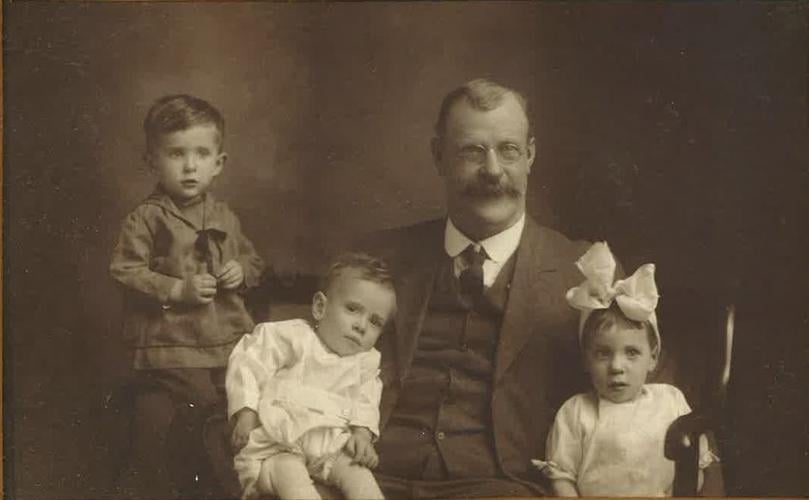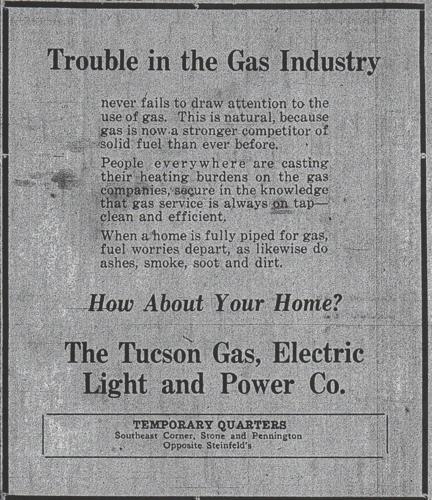Note to readers: This is a reprint of a 2015 Arizona Daily Star article.
A man who helped light up Tucson started his career at sea while he was still a boy.
Around 1874, when he was roughly 11 years old, Frank E. “Red” Russell started traveling the East India, North Atlantic, South America and California trade routes. On a voyage to San Francisco, as the first mate on the sailing vessel Kingsport, Russell and his shipmates were caught in a heavy storm. Their ship took on water as the crew desperately tried to keep it afloat.

Frank E. “Red” Russell, shown in his uniform, became chief of the fire department in 1898.
After reaching the safety of San Francisco, Russell decided the seafaring life was not for him anymore. He and a companion, Harry Star, signed off the vessel and went in search of safer employment. He worked at gas plants, shoveling lamp black and tar, until he learned that the Western Union Telegraph Co., was hiring linemen. About 1883, he began digging post holes and went on to help build a pioneer toll line through the mountainous country of California.
By 1886, he was transferred to Tucson as district lineman of the Tucson-Yuma District by Western Union Telegraph Co.
Within two years he returned to England, married Annie Stone and brought her to Tucson. They had four children: Ernest, Selina, Frances and Ellen.

Frank E. Russell with his grandchildren. The photo was provided by great-granddaughter Ruth Dederich.
While working for the telegraph company, Russell did occasional repairs on the Arctic Ice Works, an ice plant owned by Royal A. Johnson. Johnson had started a light plant around 1882 to replace Tucson’s oil lamps with electric lights, but his idea got little support. The plant closed after a couple of years, but Russell’s association with Johnson sparked an interest in illuminating the Old Pueblo.

David Leighton
In 1892, Russell was part of a group that banded together to create a light company. The Tucson Electric Light & Power Co. and its generator in back were established across the street from the old Pima County Courthouse, at 116-120 N. Church St. (now Church Avenue), and on Jan. 1, 1893, Russell was named the first manager-operator. His salary was $40 a month.

In 1896, the company bought the Tucson Gas Co. for $14,000 and by 1901, it was called the Tucson Gas, Electric Light & Power Co.
In 1894, Russell and H.E. Sheldon established Russell & Sheldon, dealers in electrical supplies, bicycles and bicycle supplies. The firm was located in the front office of the Tucson Electric Light & Power Co. building.
By 1899, the firm was selling and renting electric lamps, motors, fans, bells, batteries, gas fixtures, stoves and ranges, and had new and used bicycles for rent, sale or exchange. Russell & Sheldon later became Russell Electric and Machine Co.
From 1895 to 1902, Russell served as a city councilman representing the first ward under mayors Henry Buehman, Gus. A. Hoff and Charles J. Schumacher.
While on the council, he led the movement for the city to obtain state-owned land south of Camp Street (also called 11th Street, now Broadway). The boundaries were approximately Scott Street to the west, Eleventh Street to the north, Fifth Avenue to the east and Fourteenth Street to the south. The land had once been the site of Camp Lowell, and the whole thing at the time was used as the military plaza.
After obtaining the land, Russell and the city council set aside part of it for Tucson’s third public library, the Carnegie Free Library, and also for a smaller military plaza, now called Military Plaza Park or Armory Park.
The rest of the land was subdivided and sold off to raise money for a new sewer system and parks.

Russell Avenue was named for a man who preferred the ground beneath his feet, rather than the sea.
In 1899, when city engineer Phil Contzen surveyed the Military Plaza Subdivision, he added Russell Street (now Russell Avenue) at the southern end to honor the man who advocated for the land purchase. It’s likely the street had been originally named by the city council.
In 1898, Russell became the first chief of the reorganized Tucson Volunteer Fire Department.
In 1904 the generating facilities for the Tucson Gas, Electric Light and Power Co. were moved to West Sixth Street, across from the Russell family home at 306 W. Sixth St.
Ruth Dederich, a great-granddaughter of Russell’s, remembered her mother telling her that, “Whenever there was a fire at the (generating) plant, Russell would make his wife take whoever was in the house and put them in the car, day or night. They would drive around until the fire was put out. Russell was always afraid there would be an explosion.”

Tucson Gas, Electric Light and Power Co. ad, Arizona Daily Star, Sept. 2, 1925
The generating facilities later served as Tucson Electric Power Co.’s headquarters, from 1967 to 1999.
By 1911, Federal Light and Traction Co. of New York City owned most of the stock in the Tucson Gas, Electric Light and Power Co., but Russell remained manager of the enterprise. By 1912, the company’s office was at 83 N. Stone Ave.
On April 15, 1923, while still manager of the electric company he helped establish, Russell died at age 59.
The current Tucson Electric Power headquarters at 88 E. Broadway sits on land that was part of the ground that Russell and the city council obtained back in 1899.
Take our latest video quiz to test your knowledge of Tucson history and facts.









